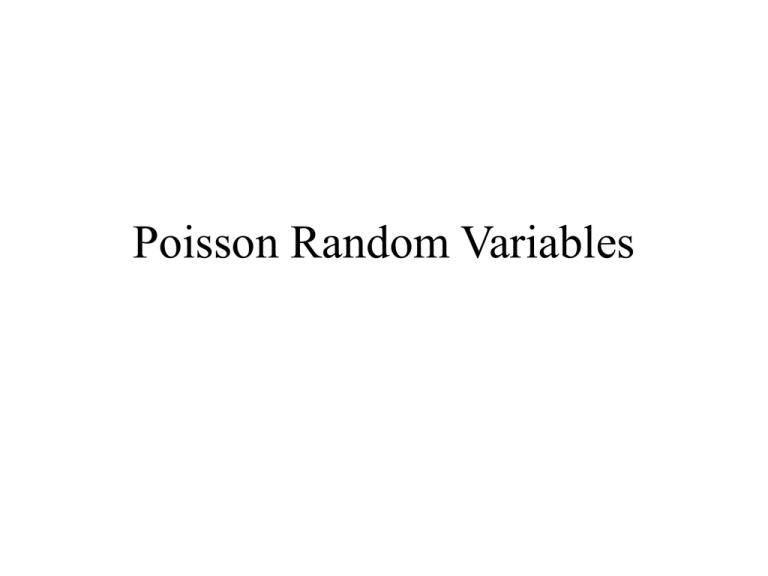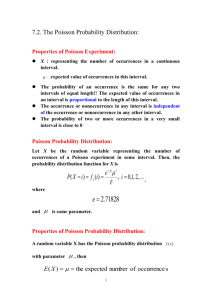Poisson Random Variables
advertisement

Poisson Random Variables Number of occurrences • Let Y represent the number of occurrences of an event in an interval of size s. • Here we may be referring to an interval of time, distance, space, etc. • For example, we may be interested in the number of customers Y arriving during a given time interval. • We call Y a Poisson random variable. Poisson R. V. • A random variable has a Poisson distribution with parameter l if its probability function is given by p( y) y l l e y! where y = 0, 1, 2, … We’ll see that l is the “average rate” at which the events occur. That is, E(Y) = l . Queries • If the number of database queries processed by a computer in a time interval is a Poisson random variable with an average of 6 queries per minute, find the probability that 4 queries occur in a one minute interval. 64 e6 p(4) 0.13385 4! poissonpdf(l, y) poissoncdf(l, y) is also provided on the TI-83 Fewer Queries • As before, for the Poisson random variable with an average of 6 queries per minute… • find the probability there are less than 6 queries in a one minute interval: P(Y 6) P(Y 5) poissoncdf (6,5) 0.44568 Some PoissonVariables • Number of incoming telephone calls to a switchboard within a given time interval; • Number of errors (incorrect bits) received by a modem during a given time interval; • Number of chocolate chips in one of Dr. Vestal’s chocolate chip cookies; • Number of claims processed by a particular insurance company on a single day; • Number of white blood cells in a drop of blood; • Number of dead deer along a mile of highway. Many short intervals • To derive the Poisson probability distribution, think of the interval as being comprised of many, say n, very short successive intervals. x x 0 x xx xx x x x s • Suppose in each interval, either there is an occurrence or there’s not. “like Bernoulli trials” • So Y = y occurrences is like y successes in n trials. • Treat it like a binomial experiment, but let the time intervals get very short (i.e., let n get very large). As n goes to infinity… • Let l = np, the expected number of successes. Taking the limit lim C p (1 p) n n y y n y C lim n n y n l y (1 ln ) n y n(n 1) (n y 1) l y l n l y lim (1 ) (1 n n) y n y! n ly n(n 1) (n y 1) l n l y lim (1 ) (1 n n) n(n)(n) (n) y ! n ly n n 1 n 2 n ( y 1) l n l y lim (1 ) (1 n n) n n n n n y! 1 -l e 1 1 1 1 As n goes to infinity… • With l = np held constant, as n gets large, we have found y l l e n y n y Cy p (1 p) y! • Consequently, we may use a Poisson probability to approximate binomial probabilities when n is large (and p is small). ( Suggests large n and l = np < 7.) Compare • Consider a binomial experiment with n = 200 and p = 0.03, so that l = np = 6. • Determine the probability of 4 successes. Also, approximate the probability using Poisson distribution. Poisson mean, variance • If Y is a Poisson random variable with parameter l, the expected value and variance for Y are given by E (Y ) l and V (Y ) l ( and the proof is too good to pass up) Expected number of arrivals • The expected value for a Poisson random variable: y 0 y 0 E (Y ) yp( y ) y y l y e l y! l y el y 1 y 1 y! l y el ( y 1)! l y 1 l y 1e l ( y 1)! since first term is zero, start with y = 1 cancelling the common factor distributing out one l Expected number of arrivals • The expected value for a Poisson random variable: E (Y ) l l y 1e l y 1 ( y 1)! l z e l z 0 z! l l p( z ) z 0 l If y = 1, 2, 3,… then y – 1 = 0, 1, 2, … Let z = y – 1. a sum of Poisson probabilities =1 , as claimed. Deriving Variance • Deriving the variance for a Poisson random variable proceeds in a similar manner. • As we’ve seen before, to get E(Y2), you first determine that E[Y(Y – 1)] = l2. (how?) • And so, E(Y2) = E[Y(Y – 1)] + E(Y) = l2 + l. • Finally, V(Y) = E(Y2) – [E(Y)]2 = (l2 + l - l2 = l.





